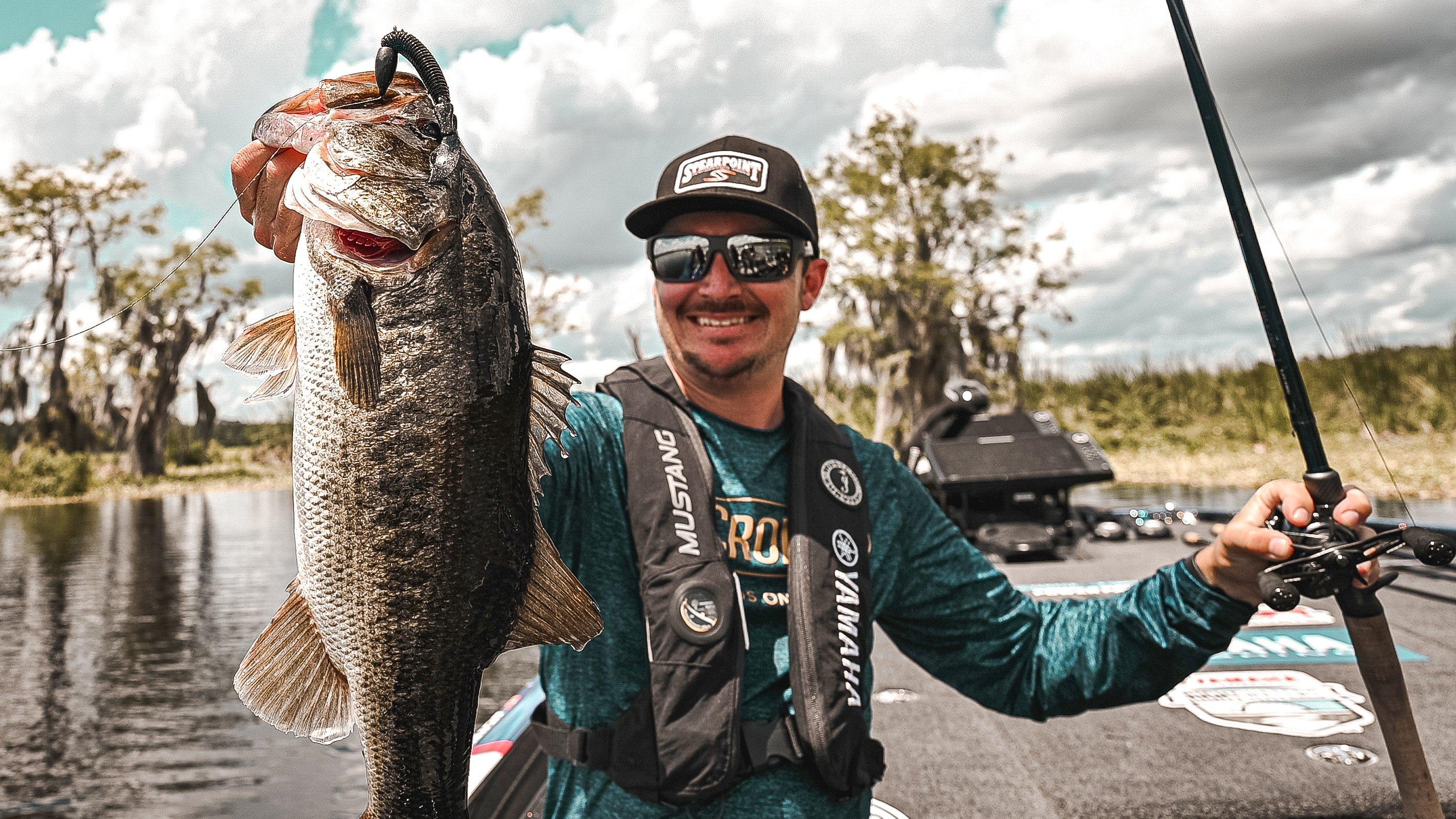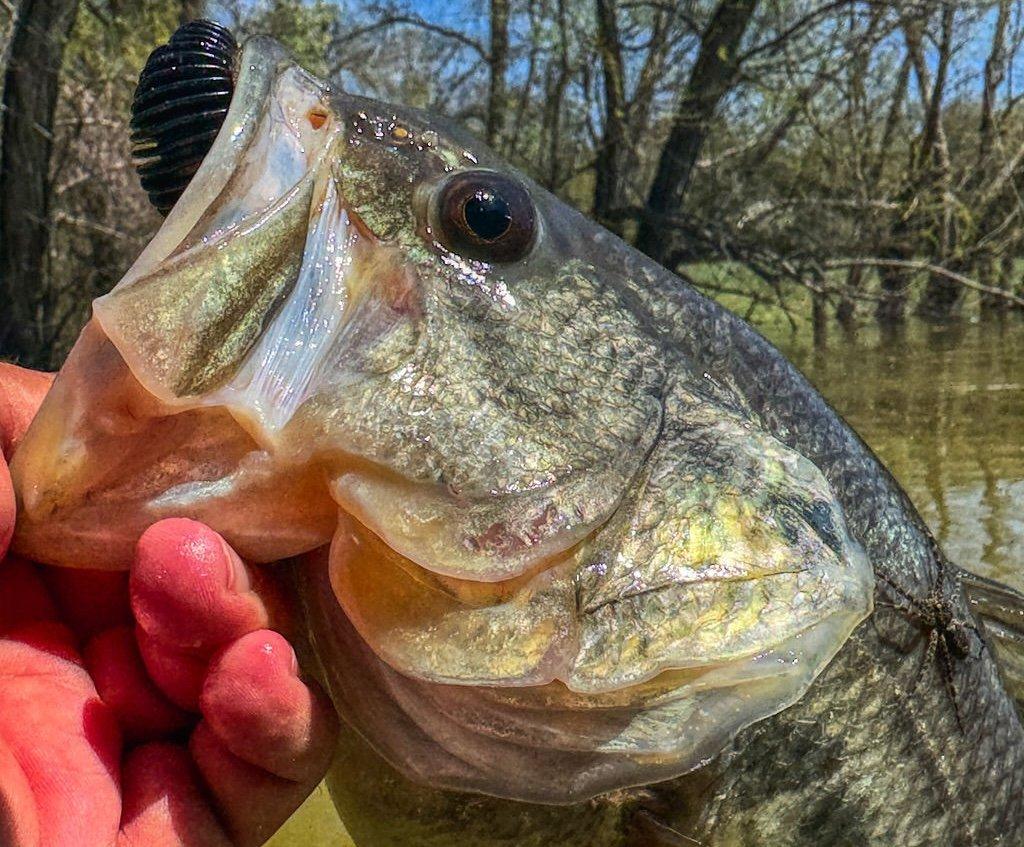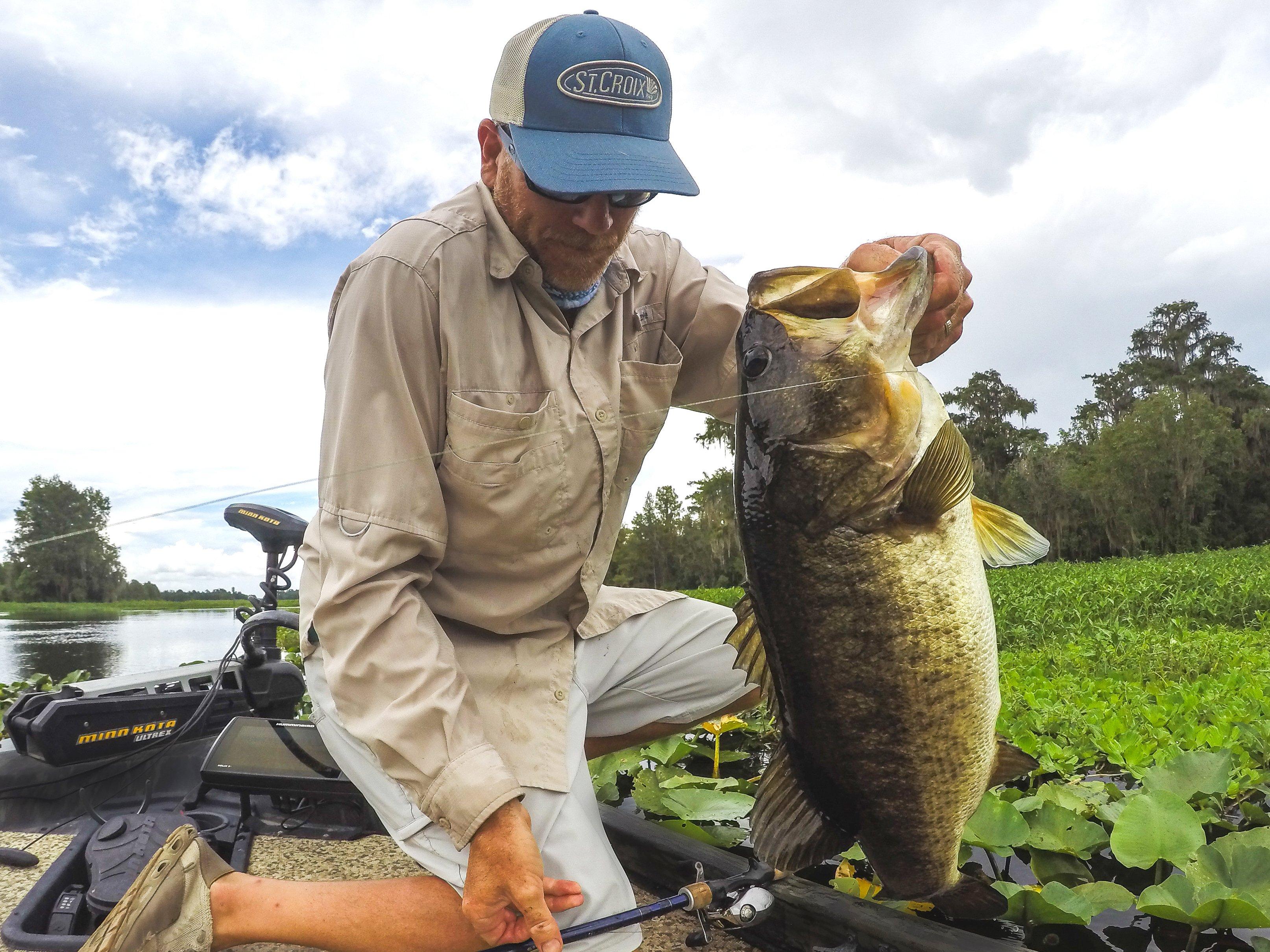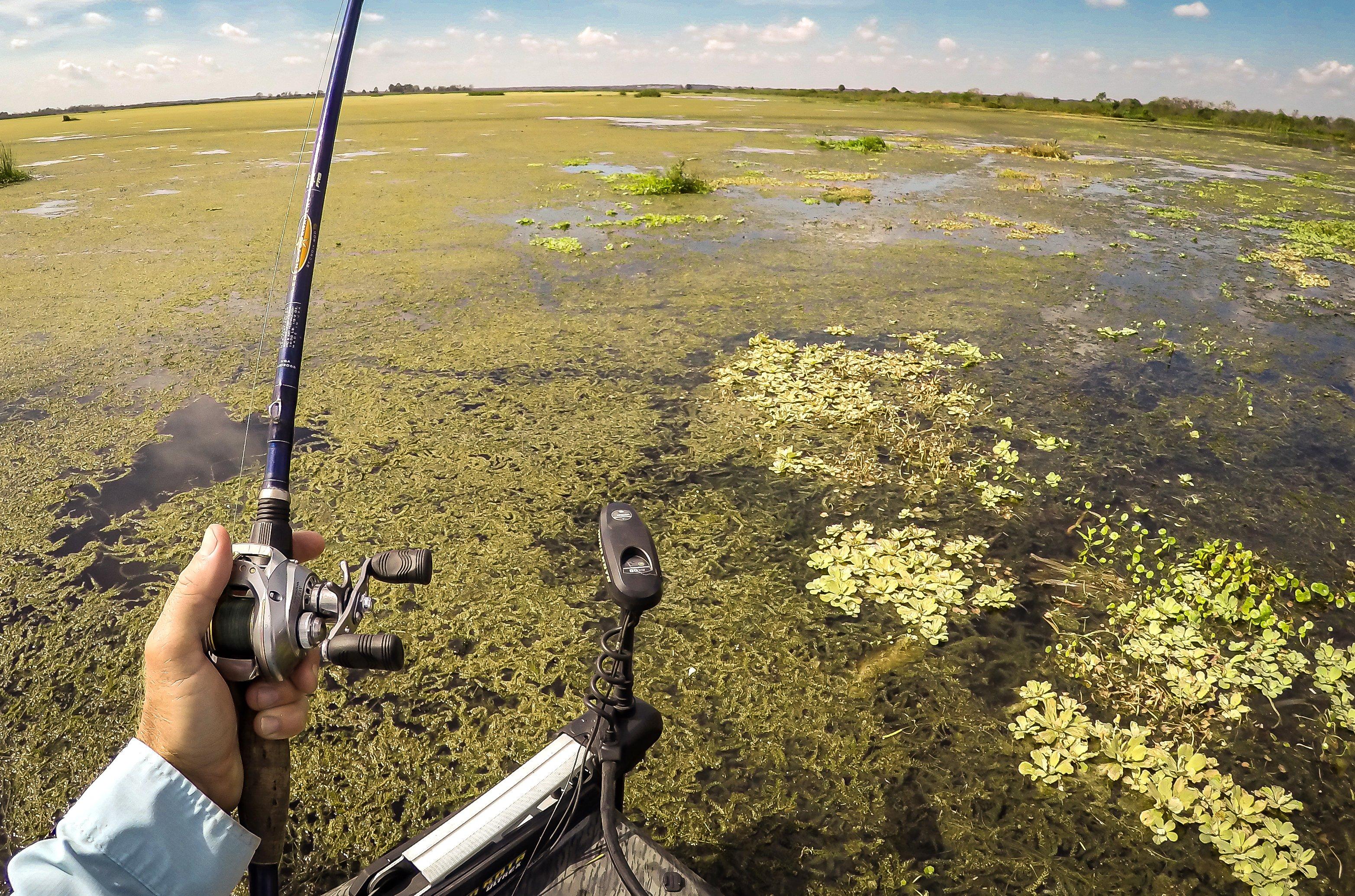Flipping for big fish in shallow cover is just as effective as it’s ever been, and requires a minimum of tackle. Here’s a look at the history and details of this classic technique
The old-school technique of flipping shallow cover for big largemouths can almost seem to be a forgotten art, with so many anglers now focused on using electronics for offshore strategies. Yet, under specific circumstances, flipping remains one of the simplest — and most effective — techniques available for putting a big limit of bass into the boat.

There is a good reason that flipping shallow cover for spring time bass has been around as long as it has. It works. Image by Joe Balog
So, what is flipping? Even asking such a question could be considered blasphemy to our older readers. Flipping defined bass fishing in the 1980s. Today, though, many younger anglers can’t truly define the word and technique. So we’ll start there.
GET YOUR FLIPPIN’ HISTORY RIGHT
The term “flipping” originated from a technique developed in California by pioneers like Dee Thomas and David Gleibe. The year was 1975, and cast-for-cash events were gaining momentum. While the rest of the field used traditional methods for probing heavy cover, early flippers went commando, delivering their lures to the tightest reaches with long rods.
Believe it or not, the technique originated using poles with fixed lines and no reels. It was called “tule dipping,” and it was very similar to cane-poling for panfish. Modified for bass, these poles held heavy line and weedless jigs, and they were simple but effective for contacting fish that others couldn’t reach. Original dipping poles were 12 feet long.
Soon, competitors began to complain that the tule-dipping crew had an unfair advantage, which caused tournament organizations to place a length limit on rods and poles. Initially, 7 ½ feet was the cap, and that meant no more dipping.
Not surprisingly, tournament anglers adapted. Rather than dip their lures on a fixed string, anglers began developing ways to swing lures into tight spots using the new, shorter rods. The flipping technique — then coined flippin’ — was born.

A variety of soft-plastics work well for flippin’, but but heavy cover often calls for compact bodies and heavy weights. Image by Jason Sealock
Flippin’ uses a fixed amount of fishing line, but not just line hanging from the tip of a pole. Instead, a rod with guides is employed along with a stout baitcast reel. For starters, enough line is let out from the spool to allow the lure to dangle at the butt section of the rod, say just a foot or so less than the overall rod length with the rod held upright. Then, an additional arms-length of line is peeled off the reel by the hand not holding the rod.
What we have now is a vertical rod, a lure dangling down near the reel, and the angler holding an additional arms-length of line. The rod tip is lowered, allowing the lure to begin to swing first toward the angler, then toward the target, like the pendulum on a grandfather clock.
As the lure continues to swing toward the target, the angler follows course with the arm’s length of line, allowing the lure to continue traveling until all the line is out. By now, the lure should be at the target, ensured by keeping the boat the perfect distance away.
FLIPPIN’ AIN’T PITCHING
There is a difference in the two techniques, and this is where some of the confusion comes in. In most cases, flippin’ is done at ranges of 10 to 25 feet. This allows for that fixed amount of line to be manageable and for pinpoint accuracy of the lure.
Flippin’ is a fixed-line technique. The idea is for the reel to be engaged so that the spool does not spin and the hook can be set instantly on a bite. Flippin’ should not be confused with “pitching,” which is used in similar short-range, shallow-water scenarios, but allows the reel spool to spin. Pitching is, in essence, an underhand cast, like tossing a horseshoe.
If you’re following along, by now you’re wondering how flippin’ adapts to new targets as we move down the bank. Therein lies the true art form of the technique. Flippin’ — when done correctly — relies on the angler positioning the boat nearly an identical distance between each target or each flip. Again, the amount of line is intended to be fixed. So, when flippin’ bushes 10 feet from the boat, and the next bush is slightly farther away, an experienced flipper will bump in with the trolling motor to ensure the next flip is in the 10-foot range.
To those new to the technique, this may seem complicated. But once refined, flippin’ is the most efficient technique in all of bass fishing. And nothing racks up the score in tournament fishing like efficiency.

Once an angler gets the hang of boat placement around cover, flippin’ can be an extremely efficient way to catch big bass. Image by Joe Balog
Flippin will catch shallow bass faster than any technique, as it’s truly one-step ahead of cane-poling. Most fish are swung aboard immediately after the hookset, adding to efficiency, and decreasing lost fish. When a flipper has their number, the bass are in trouble.
Don’t Miss: 3 WAYS TO GO FISHING AND GET PAID FOR IT
THE RIGHT FLIPPIN’ TACKLE
Rods used for flippin’ were originally called “Flippin’ Sticks.” In the early days, most were telescopic, as storage areas in bass boats of the day were often maxed out at seven feet in length.
As times evolved and boats became bigger, many manufacturers built 8-foot, non-telescopic flippin’ sticks. When major tournaments reduced their regulations, allowing for longer rods, a few manufacturers released flippin’ rods up to 10 feet in length. But they never caught on.
Today, most flippin’ sticks are again 8 feet in length, heavy powers and slightly parabolic. A rod with a bit of midsection flex will hook and land more fish than a pool cue.

Today, most anglers use heavy rods in the 8-foot range to flip jigs or plastics into heavy cover. Image by Joe Balog
All modern baitcast reels will work, though experienced flippers in big-fish zones like metal reels over flimsy carbon bodies. Certain angler groups prefer left-hand retrieve reels, especially Florida flippers like me. That allows the power-hand to be on the rod at all times, while reeling with the opposite.
Braided line revolutionized the flippin’ technique, especially in waterways with heavy vegetation. Lily pads, hydrilla, hyacinth mats, milfoil, gator grass; all require braided line. The no-stretch properties move big fish fast, and braid cuts through grass instantly.
Occasionally, clear water scenarios present a need for fluorocarbon lines. Most times when flippin’, though, the cover is so thick that braided line will prevail.
Flippin’ lures depend entirely on cover type and region. For thick, matted vegetation, squat plastics on heavy sinkers work best. In bushes, bulky jigs are the go-to. For spawning bass, sometimes stick-worms can’t be beat.

A jig and soft-plastic craw makes a classic combination for flippin’ in heavy cover. Image by Joe Balog
Major bass tournaments have been won flippin’ craw-worms, lizards, Brush Hawgs and Beavers. There’ve been better mousetraps developed constantly since the technique began, when pioneers used vinyl jigs with homemade weed guards.
While the components advance and the lures evolve, the technique behind flippin’ hasn’t changed a bit. It’s still the same concept: swing it in there, and horse ‘em out.
The simplicity is part of the attraction, but so is the effectiveness and the thrill. When you flip a jig into a flooded willow and the whole bush shakes from the strike of a giant bass, you’ve just experienced one of the best split-seconds in bass fishing.
Don’t Miss: FLORIDA CHARTER CAPTAIN ARRESTED AFTER TIRADE CAPTURED ON CAMERA












